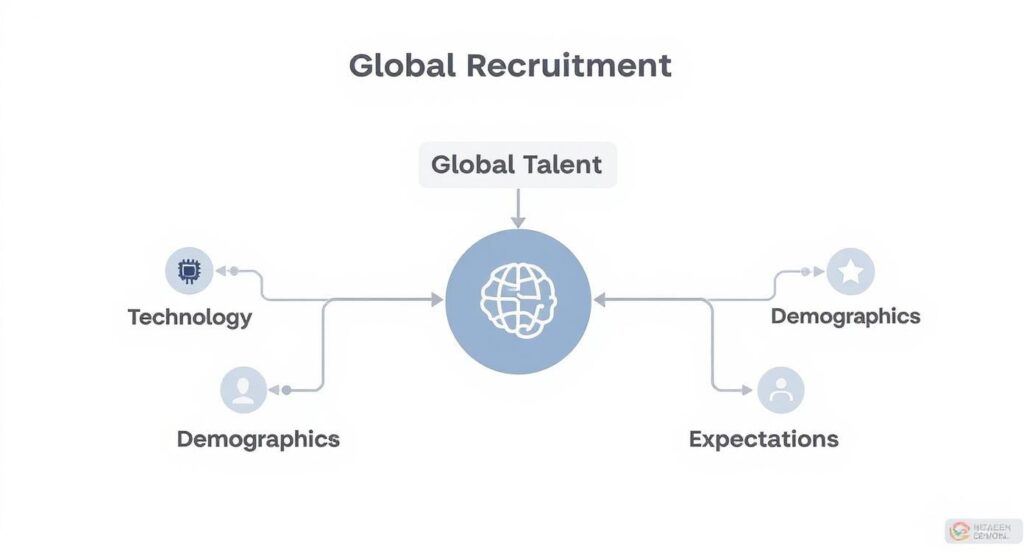At the heart of today’s global recruitment trends is a major shift away from old-school hiring towards a smarter, technology-powered approach. We’re seeing huge transformations, like the widespread use of Artificial Intelligence (AI) to make things more efficient, a strategic pivot to skills-first hiring over just looking at degrees, and an intense focus on building an irresistible employer brand to pull in top talent in a crowded market.
Navigating the New Global Talent Market
Welcome to the new world of talent acquisition. Keeping up with global recruitment trends isn’t just about gaining an edge anymore—it’s a fundamental business need.
Picture the global talent market like a giant, interconnected chessboard. Every move your company makes is shaped by powerful forces: disruptive tech, demographic shifts, and what candidates now expect. To win, you have to understand the entire board, not just the squares right in front of you.
This new environment demands a much more intelligent and nimble way of attracting and keeping the best people. The old method of just posting a job and waiting for CVs to roll in is finished. Today, success requires a proactive, multi-pronged strategy that sees change coming before it even arrives.
The Forces Reshaping How We Hire
A few interconnected shifts are completely overhauling the recruitment process. These aren’t just buzzwords; they’re deep currents changing how talent flows across the globe. Getting to grips with them is the first step to building a hiring function that’s ready for whatever comes next.
Here’s a quick look at the key global recruitment trends and their impact.
Key Global Recruitment Trends at a Glance
| Trend | Core Concept | Primary Business Impact |
|---|---|---|
| Predictive AI | Using AI to identify best-fit candidates, predict success, and reduce bias. | Increases hiring quality and speed; improves diversity and fairness. |
| Skills Over Degrees | Prioritising verifiable competencies and practical abilities over formal education. | Unlocks a wider, more diverse talent pool and finds better-suited candidates. |
| Candidate Experience | Creating a seamless, respectful, and engaging hiring journey for applicants. | Boosts employer brand, attracts more top talent, and reduces candidate drop-off. |
| Data-Driven Decisions | Using analytics to optimise every stage of the hiring funnel, from sourcing to offers. | Improves recruitment ROI, enhances efficiency, and provides clear strategic direction. |
These forces are working together to create a more dynamic and demanding hiring landscape.
A few of the key drivers include:
- Predictive AI: Artificial intelligence is no longer just about basic automation. It’s now a strategic partner, helping recruiters pinpoint the best candidates, forecast their potential success, and strip unconscious bias from the hiring process.
- Skills Over Degrees: Companies are finally realising that a university degree isn’t always the best indicator of someone’s ability to do the job well. A skills-first mindset, which zeroes in on proven abilities, is opening the door to a more diverse and capable pool of talent.
- The Candidate Experience: In a world where everyone has a voice, your reputation as an employer is everything. Candidates expect a smooth, engaging, and respectful hiring journey. One bad experience can tarnish your brand and scare away future talent.
- Data-Driven Decisions: Gut feelings are out; analytics are in. Recruitment leaders are now using hard data to fine-tune every part of the hiring funnel, from which sourcing channels work best to offer acceptance rates, making sure their strategies are both effective and efficient.
The modern talent acquisition function has to be a blend of art and science. It needs the human touch for building relationships and understanding cultural fit, but it also needs the analytical rigour to make smart, evidence-based decisions at scale.
This guide is your map for this new territory. We’ll dive deep into each of these global recruitment trends, offering data-backed insights and practical strategies to help you make the right moves. By understanding what’s changing and why it matters, you can build a recruitment engine that doesn’t just fill roles but fuels long-term business growth. For a more detailed analysis on this topic, you can also read our global in-house sectoral report for deeper insights.
How AI Is Redefining Modern Recruitment
Artificial intelligence has quickly gone from a buzzword to a fundamental part of the modern recruiter’s toolkit. Think of it less as a replacement for human instinct and more as an incredibly efficient co-pilot. AI is brilliant at handling the repetitive, data-heavy tasks that eat up so much time, freeing up your team to focus on the human side of hiring—strategy, relationships, and culture.
Picture this: you have a single opening and a mountain of applications. An AI-powered Applicant Tracking System (ATS) can sift through thousands of CVs in minutes, flagging candidates whose skills and experience actually match what you’re looking for. This lets recruiters spend their valuable time connecting with the most promising people, not just filtering out the noise.
This kind of smart automation is touching every part of the hiring journey and is a major force behind the biggest global recruitment trends we’re seeing today.
The infographic below breaks down the key forces—Technology, Demographics, and Expectations—that are reshaping how we find and hire talent.

As you can see, these elements are all connected, with AI acting as the engine that helps companies adapt to new demographic shifts and rising candidate expectations.
Automating the Repetitive and Amplifying the Human
One of the first things you’ll notice when you bring AI into your recruitment process is how much administrative weight it lifts. This isn’t just about saving time; it’s about creating a better experience for everyone involved.
Here’s what that looks like in the real world:
- Intelligent Sourcing: AI platforms can scan professional networks, job boards, and even your own internal databases to find great passive candidates—people who fit the bill but aren’t actively job hunting. Suddenly, your talent pool is much, much larger.
- 24/7 Candidate Engagement: AI chatbots on your careers page can answer applicant questions instantly, any time of day. Whether it’s an update on an application or a query about benefits, candidates get the information they need without having to wait.
- Automated Interview Scheduling: The back-and-forth of scheduling interviews, especially across different time zones, is a huge headache. AI tools can sync with everyone’s calendars, find a time that works, send the invites, and even handle rescheduling.
These tools do more than just make things efficient; they create a smoother, more professional journey for candidates. When you consider that nearly 60% of job seekers have given up on an application because it was too long or complicated, you can see how removing that friction is a game-changer.
Driving Strategic Decisions with Predictive Analytics
But AI is more than just an admin assistant. Its real power lies in its ability to predict outcomes, shifting recruitment from a reactive function to a proactive, strategic one. By crunching historical hiring data, AI can spot the patterns that lead to successful hires, like specific skills, career paths, or assessment scores.
This opens up a world of possibilities:
- Improve Quality of Hire: Predictive models can score candidates on their likelihood of success, helping recruiters focus their energy where it will count the most.
- Reduce Unconscious Bias: When set up and monitored correctly, AI can focus purely on job-related skills and experience, helping to sideline human biases around things like age, gender, or background.
- Optimise Sourcing Channels: AI can tell you which channels consistently bring in the best candidates, so you can put your recruitment budget to work in the smartest way possible.
The true power of AI in recruitment isn’t just doing things faster; it’s about making smarter, data-informed decisions at every stage of the hiring process.
This shift is especially critical in hyper-competitive markets. Take India’s Global Capability Centres (GCCs), for example. They are evolving from support functions to core innovation hubs, and with over 1,600 GCCs fighting for top talent in fields like cybersecurity and digital transformation, AI-driven hiring is no longer a luxury—it’s essential.
Of course, with any discussion of AI, the question of jobs comes up. While AI does automate tasks, its primary role is to enhance what humans can do, not replace them. To dig deeper into this, you can explore the relationship between ChatGPT and potential job loss in our detailed article. Getting this balance right is the key to using AI effectively and ethically.
Winning with a Skills-First Hiring Strategy

The old playbook of relying on university degrees and predictable career paths is gathering dust. In its place, forward-thinking organisations are embracing a smarter, more inclusive approach: skills-first hiring. This isn’t just a minor tweak; it’s a fundamental shift in focus from where a candidate learned to what they can actually do.
Think about it this way: if you were hiring a world-class musician, you wouldn’t just glance at their diploma. You’d ask them to play. Skills-first hiring applies that exact same, common-sense logic to the corporate world, prioritising proven abilities over paper credentials.
It’s about changing how we measure potential. Instead of using a degree as a rough guess for competence, this strategy uses practical assessments to see a candidate’s skills in action. The outcome? A much more accurate prediction of on-the-job success and a workforce that’s genuinely ready for the challenges ahead.
Putting Skills to the Test
Adopting a skills-first mindset means going beyond the usual interview questions. It’s about creating scenarios that mirror the real work a person will be doing, giving you a clear window into their capabilities.
Some of the most effective methods we’ve seen include:
- Hands-On Technical Assessments: For a software developer, this might be a coding challenge. For a data analyst, it could be a task to analyse a dataset and present their findings. Simple, direct, and incredibly revealing.
- Portfolio Reviews: In creative fields like design or marketing, asking someone to walk you through their portfolio is invaluable. It provides tangible proof of their skills, creative thinking, and ability to deliver results.
- Situational Challenges: Give candidates a real business problem your team has faced and ask how they’d tackle it. This move uncovers their critical thinking, problem-solving instincts, and strategic mindset.
These techniques give you objective data that is far more dependable than a CV alone. In fact, research shows that skill-based organisations are 57% more likely to anticipate and respond effectively to change—a massive advantage in today’s fast-moving market.
Unlocking a More Diverse Talent Pool
Perhaps the most powerful benefit of a skills-first strategy is the positive ripple effect it has on diversity and inclusion. When you drop arbitrary barriers like specific degree requirements, you immediately open the door to a much wider, more vibrant pool of talent.
This approach gives a fair shot to brilliant individuals from non-traditional backgrounds—people who are self-taught, attended bootcamps, or honed their skills through hands-on experience. It truly levels the playing field, ensuring the best person for the job is chosen based on their ability, not their pedigree. This is a key reason it’s becoming one of the most important global recruitment trends.
A skills-first mindset doesn’t just find better candidates; it builds a more resilient and representative workforce by rewarding demonstrable competence over credentials. It is the ultimate meritocratic approach to talent acquisition.
In fast-growing markets with specific skill shortages, this strategy is no longer a “nice-to-have”—it’s essential. In India, for example, the job market is seeing roughly 9% growth. Yet, there’s a major gap between the high demand for advanced skills in AI, data science, and cybersecurity and the available talent. Embracing skills-first hiring is crucial for companies to bridge this divide and secure the expertise needed to win.
An Actionable Framework for Integration
Switching to a skills-first model doesn’t mean you have to rip up your entire hiring process. You can start with small, impactful changes that yield immediate results.
- Rewrite Job Descriptions: Cut out unnecessary degree requirements. Focus on the actual competencies needed for success. Instead of “Bachelor’s degree in Marketing,” try “Proven experience running successful digital ad campaigns.”
- Integrate Practical Assessments: Introduce a small, relevant work-sample test early in the process. This helps screen for practical skills before you invest significant time in later interview stages.
- Train Your Hiring Managers: Give your interviewers structured questions designed to explore specific skills and past behaviours. This moves the evaluation away from “gut feeling” and towards consistent, fair assessments for every candidate.
By taking these steps, you can start future-proofing your talent strategy, one hire at a time. To get a deeper understanding of the skills landscape across the country, the findings of the India Skills Report 2023 offer some comprehensive insights.
Building a Magnetic Employer Brand

In today’s hyper-transparent job market, your employer brand has become your most valuable recruitment asset. The old power dynamic has well and truly flipped; candidates now “shop” for jobs with the same care and attention that consumers use for big purchases. They dig into reviews on employer-rating websites, look for social proof on professional networks, and listen intently to what current and former employees are saying.
This shift makes building a magnetic employer brand one of the most vital global recruitment trends out there. It’s no longer enough to just dangle a competitive salary. Top talent is searching for a much deeper connection—a real sense of purpose, a culture that feels supportive, and clear pathways for growth. Your brand is the story you tell that brings all these pieces to life.
A weak or inauthentic brand can actively push away the very people you’re trying to attract. On the flip side, a strong brand acts as a powerful filter, drawing in candidates who are not just skilled but also a natural fit for your organisation’s values.
Crafting a Compelling Employee Value Proposition
At the very heart of any great employer brand is a compelling Employee Value Proposition (EVP). The simplest way to think about your EVP is as the promise you make to your team in exchange for their talent and commitment. It’s what spells out why your company is a uniquely rewarding place to build a career.
A strong EVP goes way beyond the basics of salary and benefits. It needs to answer the one crucial question on every top candidate’s mind: “Why should I work for you?”
To build an EVP with real pulling power, focus on these core pillars:
- Mission and Purpose: Be crystal clear about your organisation’s “why.” People want to feel that their work adds up to something meaningful, and a strong sense of purpose is an incredible motivator.
- Culture and Community: Define the day-to-day experience of working at your company. Is it collaborative and innovative? Flexible and autonomous? Authentic stories from your current employees are the absolute best way to showcase your culture.
- Career Growth and Development: Lay out the opportunities for learning and advancement. Today’s top talent puts a premium on growth, so demonstrating clear career pathways is essential for attracting ambitious individuals.
A well-defined EVP isn’t just a marketing slogan; it’s the authentic sum of your culture, mission, and growth opportunities. It’s what you offer, how you operate, and why people should care enough to join and stay.
Turning Candidates into Brand Advocates
The candidate experience is where your employer brand is truly put to the test. Every single interaction, from the first click on an application to the final decision, shapes a candidate’s perception of your organisation. A seamless, respectful, and communicative process can turn applicants into brand advocates—even the ones who don’t get the job.
Conversely, a poor experience creates detractors. In fact, over 70% of job seekers who have a bad candidate experience will share it online or with their network. This can cause significant damage to your reputation and make your future hiring efforts much more difficult.
To create a positive experience, you have to map the entire candidate journey from their perspective. Hunt down and eliminate the friction points, whether it’s a clunky application portal, poor communication from recruiters, or a disorganised interview process.
The goal is to make every candidate feel valued and respected, no matter the outcome. This human-centric approach is a cornerstone of modern talent acquisition and a defining feature of leading employer brands across the globe. By investing in your candidate journey, you build not just a pipeline of talent, but a network of advocates who will speak positively about your organisation for years to come.
Adapting Your Strategy to Regional Markets
A global recruitment strategy that doesn’t bend will inevitably break. It’s tempting to take a successful trend, like AI adoption or skills-based hiring, and apply it everywhere. But that’s like trying to use the same key for every lock—it just won’t work. To truly connect with talent, you have to translate global trends into locally relevant actions.
Think of your global strategy as the main melody of a song. That core tune stays the same, but the instruments, tempo, and rhythm have to shift to fit the culture of each place you play it. This is what turns a generic tune into a local hit. The same principle applies when you’re hiring across different markets.
Understanding these regional nuances is everything. A high-speed, tech-driven approach that works wonders in North America could fall completely flat in Asia-Pacific if it ignores local communication styles or candidate expectations. Adapting your strategy isn’t just a final touch; it’s the critical step that makes your global recruitment efforts actually work.
Europe: Navigating Regulation and Talent Mobility
In Europe, the recruitment game is heavily influenced by strict data privacy rules, especially the General Data Protection Regulation (GDPR). This has a massive impact on how you can use AI-powered sourcing tools or even manage a candidate database. Unlike other regions, recruiters here must put compliance first, making sure every single step is transparent and secure.
At the same time, talent mobility within the European Union creates a uniquely fluid and dynamic talent pool. A skills shortage for engineers in Germany can be tackled by sourcing candidates from Spain or Poland. This makes cross-border recruitment the norm, not the exception. It also means you need a deep understanding of different labour laws, salary benchmarks, and cultural expectations across the continent to build an employer brand that resonates with a diverse, multinational audience.
North America: Competing on Speed and Innovation
The North American market, especially the US, is all about intense competition and a breakneck pace of innovation. The “war for talent” here is real, and speed is your biggest weapon. Companies in this region are often the first to jump on new recruitment technologies, from sophisticated AI sourcing platforms to immersive virtual reality interviews.
The candidate experience is king. A slow, clunky hiring process can mean losing a top candidate to a competitor in a matter of days. To win, your applicant journey has to be seamless, engaging, and fast. Employer branding also plays a massive part, with a heavy emphasis on company culture, perks, and clear paths for career progression to attract the best of the best.
A global strategy provides the ‘what,’ but a regional approach defines the ‘how.’ Success lies in harmonising your overarching goals with the specific cultural, regulatory, and economic realities of each local market.
APAC: Embracing Mobile-First and Diverse Cultures
The Asia-Pacific region is incredibly diverse, from mature markets like Japan to fast-growing economies like Vietnam and Indonesia. A single “APAC strategy” is a recipe for failure. One common thread, however, is the dominance of mobile technology. Recruitment here is increasingly mobile-first, with candidates doing everything on their smartphones—applying for jobs, chatting with recruiters, and even completing interviews.
Cultural nuances are everything. In Japan, for instance, the hiring process is often more formal and relationship-driven, with a high value placed on long-term loyalty. Head over to Singapore, and you’ll find a highly dynamic market focused on specific, in-demand skills. You have to adapt your communication style, interview etiquette, and overall value proposition for each country to build trust and attract local talent.
India: A Hub of Growth and Specialised Skills
India’s job market is in the middle of a massive growth spurt, fuelled by its booming tech and manufacturing sectors. This has created a high-demand environment for specialised talent, particularly in IT and engineering.
The numbers tell the story. Projections show India’s recruitment industry is poised for huge expansion, with around 500,000 new job opportunities expected across key sectors. This growth is backed by a 19% increase in hiring intent and an anticipated 40% rise in staffing activities. The IT sector alone is forecast to see a 15-20% increase in job openings, driven by demand for skills in AI, machine learning, and data analytics. For any company looking to tap into this vibrant talent pool, understanding these local dynamics is the key to success. You can learn more about the outlook for India’s recruitment industry and its exciting transformation.
Here’s the rewritten section, designed to sound completely human-written and natural, following the provided style guide.
Your Action Plan for Future-Ready Recruiting
Knowing the major global recruitment trends is one thing, but actually turning those ideas into a real-world strategy is where the magic happens. Think of this as your roadmap to building a smarter, more agile, and genuinely human-first recruitment function. It’s time to get practical.
First things first: take a hard look at your current recruitment tech stack. You can’t build a house for the future on a crumbling foundation. This isn’t just about listing the software you pay for; it’s about seeing how well it all works together. Are your tools talking to each other, or are they creating frustrating data silos?
Prioritise Your Key Initiatives
Once you have a clear picture of your tech capabilities, you can start making some smart choices. The key is to focus on changes that will give you the biggest bang for your buck with manageable effort. This helps you build momentum and score some early wins—which is absolutely vital for getting the rest of the organisation on board for the bigger stuff.
Here’s a straightforward, step-by-step framework to get you started:
- Pilot a Skills-Based Programme: Don’t try to boil the ocean. Pick one high-priority, notoriously hard-to-fill role to start. Team up with the hiring manager to rewrite the job description, shifting the focus from university degrees to the actual skills needed to do the job well. Then, introduce a practical work-sample test early in the process to see what candidates can really do.
- Assign Ownership for Candidate Experience: Make someone accountable. Designate a specific person or a small, dedicated team to map out and own the entire candidate journey. Their one and only mission? To find and fix every little point of friction, from a clunky application form to a confusing offer letter. This focus is what drives real, continuous improvement.
- Modernise Your Employer Brand Story: Your brand has to connect with what today’s talent actually cares about. It’s no longer just about the salary and benefits. You need to talk about your company’s mission, its culture, and how you invest in your people’s growth. The best way to do this is with authentic employee stories and testimonials that bring your company’s narrative to life.
Building a future-ready recruitment function is a journey, not a destination. It requires a commitment to continuous improvement, a willingness to experiment with new approaches, and a relentless focus on creating value for both candidates and the business.
Measuring Success and Driving Adoption
For any of these initiatives to have a lasting impact, you have to define what success looks like right from the get-go. Tie your efforts to clear, measurable Key Performance Indicators (KPIs). For your skills-based hiring pilot, this could be a noticeable improvement in quality-of-hire or a reduction in time-to-fill.
When it comes to candidate experience, keep a close eye on metrics like your offer acceptance rate and candidate satisfaction scores. When you can walk into a leadership meeting with this kind of data, you’re not just sharing ideas; you’re demonstrating the tangible return on investment and building a strong case for rolling these changes out more widely.
Ultimately, getting ahead of the latest global recruitment trends comes down to a strategic mix of technology, process, and people. By taking stock of where you are now, piloting a few high-impact initiatives, and measuring your progress, you can build a recruitment engine that doesn’t just fill roles—it fuels your organisation’s long-term growth and success on a global scale.
Have a Question? We’ve Got Answers
Digging into the latest recruitment trends always brings up a few practical questions. How do you actually put these ideas into practice? We’ve gathered some of the most common queries we hear from clients and partners to give you clear, straightforward answers.
Let’s break down how to turn these global trends into real-world wins for your team.
How Can a Small Business Adopt Skills-Based Hiring Without a Big Budget?
You don’t need a massive budget to get started; you just need to be smart about it. Focus on one or two critical roles first.
Instead of sinking money into expensive assessment software, think practical. Use hands-on work samples, give candidates a short project assignment, or design structured interview questions that test their problem-solving skills in situations they’d actually face on the job. It’s a low-cost way to get direct proof of what a candidate can do.
This approach also has a great side effect: it levels the playing field. You’ll start to uncover hidden talent that traditional CV screening, with its focus on degrees and past job titles, would have completely missed.
What Is the Most Critical First Step for Using AI Ethically in Recruitment?
Before you do anything else, you absolutely must conduct a bias audit of any AI tool you’re considering. This is non-negotiable.
Work with vendors who are completely transparent about their algorithms. They should be able to show you exactly how their tools were tested to reduce demographic bias. Most importantly, always, always keep a human in the loop for the final say.
AI should be your co-pilot, not the pilot. Its job is to provide data and insights to help humans make better, more informed decisions. Never fully automate the final hiring decision—that’s how you maintain fairness and accountability.
How Can We Measure the ROI of Improving Our Candidate Experience?
It’s easier than you might think. You just need to measure a few key metrics before and after you roll out any changes.
Start by tracking your offer acceptance rate, time-to-fill, cost-per-hire, and quality-of-hire. You can also get direct feedback by sending simple surveys to both new hires and candidates who didn’t get an offer.
When you improve the candidate experience, you’ll almost always see higher acceptance rates and a stronger talent pipeline for future roles. That translates directly to your bottom line by cutting recruitment costs and boosting employee retention down the road.
Ready to build a talent strategy that’s fit for the future? Taggd specialises in Recruitment Process Outsourcing that’s built around the latest global recruitment trends. Let us help you build the agile, high-performing workforce your business needs to win.







